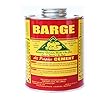If you’ve ever tried to repair torn leather or glue two pieces together, you probably realize this can be a sticky situation. Many types of adhesives are available, but choosing one suitable for leather projects can be confusing.
Whether you need adhesive to repair shoes or upholstery or finish a craft project, this guide will help you choose the best glue for leather, no matter your project.
Things to Consider When Choosing the Best Glue for Leather
- Ventilation. Be sure to use any adhesives in a well-ventilated area. Breathing in toxic fumes can be dangerous and even fatal. It is very important to take all of the proper precautions.
. - Manufacturer Instruction. Always follow the manufacturer’s package handling instructions. Some adhesives are particularly dangerous when they come in contact with skin or are accidentally ingested. Again, it is very important to take all of the proper precautions.
Top 9 Glue for Leather Comparison Table
| Picture | Name | Type of Glue | Price | Rating (1-5) |
|---|---|---|---|---|
 | 1. Petronio Shoe Products Masters Contact Cement 8oz | Rubber cement | $$ | 4.4 |
 | 2. Bob Smith Industries BSI-157H Maxi Cure/Insta-Set Combo Pack 3oz | Cyanoacrylate | $$ | 4.7 |
 | 3. Gorilla 7700104 Super Glue Gel | Cyanoacrylate | $ | 4.7 |
 | 4. Barge O22721 All Purpose Cement Quart | Rubber cement | $$$$ | 4.7 |
 | 5. Loctite - 2436365 Liquid Professional Super Glue, 2 Pack | Cyanoacrylate | $ | 4.7 |
 | 6. Beacon Adhesives Beacon 527 | Cyanoacrylate | $ | 4.6 |
 | 7. Krazy Glue KG94548R Instant Crazy Glue Home & Office Brush 0.18-Ounce | Cyanoacrylate | $ | 4.6 |
 | 8. Super Glue 15185 Gel, 12-Pack, .07oz tubes | Cyanoacrylate | $ | 4.7 |
 | 9. Aleene's Leather & Suede Glue 4oz | Unknown | $ | 4.3 |
Types of Leather Glues and Adhesives
You don’t want to get stuck with the wrong glue. Before you purchase any glue for your leather, read this section first!
Most leather glues fall into four categories, each with advantages and disadvantages.
- Polyurethane Glue. Glues made from polyurethane create foam that seeps into pores and small fabric gaps. This makes a particularly strong bond when working with leather, as it fills all of the microscopic spaces in the hide. It forms a stronger bond when exposed to moisture as it sets.
.
One drawback to polyurethane glue is that it is relatively unforgiving when repositioning the items you are gluing together, so you’ll have to be accurate the first time.
. - Rubber Cement. Rubber cement is the general glue of choice for shoemakers and movie props creators, mostly because it remains incredibly flexible even after it sets. It is a great choice to repair anything wearable where undue stiffness is impractical.
.
Rubber cement is a simple adhesive made from elastic polymers, or latex, mixed in a solvent such as acetone or ammonia. It evaporates quickly, leaving behind a sturdy rubber seal. One advantage of rubber cement is that it allows for easy repositioning of craft materials.
. - Cyanoacrylate Glue. Strong and fast-acting cyanoacrylate glue bonds very quickly, also known as super glue. You’ll have to get the placement right on the first try; however, you’ll be left with a durable, flexible, and moisture-resistant bond.
. - Silicone Glue. First developed by GE and marketed as a household adhesive and bathtub caulk, silicone glue is water- and heat-resistant. Most silicone glues become stiff as they dry, making them impractical for use on leather clothing or other projects that benefit from a more flexible adhesive.
Top 4 Best Glue for Leather Reviews
1. Petronio Shoe Products Masters Contact Cement

First made by Petronio’s in the 1950s, Master Contact Cement has long been the most popular and requested adhesive in the shoe industry.
This quick-drying cement offers a fast set-up and a waterproof bond so strong the leather will tear before the glue comes apart.
The product comes with its applicator brush for easy and convenient application.
This contact cement can also be versatile with wood, rubber, or metal materials. Great for keeping in the workshop for use in various projects or the home for quick repairs on leather shoes, upholstery, jackets, and more.
This is truly the best glue for leather that you’ll find anywhere.
2. Bob Smith Industries Maxi Cure/Insta-Set Combo Pack

Marketed for use on plastic models, Bob Smith Industries Maxi Cure/Insta-Set Combo also works great on leather. Simply apply the Maxi Cure to one piece of the material to adhere and the Insta Set to another.
The two pieces will bond instantly upon contact.
This product comes in a fresh strawberry scent, so you won’t be forced to deal with the harsh chemical smell that accompanies most other leather glues.
It is an incredibly durable adhesive that works well on various materials, including metal, plastic, wood, ceramic, rubber, glass, and leather.
Its versatility makes it invaluable for use around the house, workshop, garage, or office.
3. Gorilla 7700104 Super Glue Gel

Gorilla 7700104 Super Glue Gel is the go-to product for construction and furniture repairs and woodworking projects. It has a thick consistency and is super strong and durable, so it can be used even on rough surfaces without reducing its viscosity.
This glue holds tight instantly but dries clear in 10-45 seconds, so you know when it’s completely dry. Its gel formula promotes controlled application with precision for maximum strength.
Its resistance to extreme temperatures and moisture makes it a great choice for bonding leather outdoors, such as saddlery, boots, and even luggage.
This cyanoacrylate glue sticks to practically everything, including skin and clothing, so use it with caution. Great for more than just leather.
Use Gorilla glue on plastic, wood, metal, ceramic, rubber, leather, paper, and many more.
Keep this versatile adhesive in the barn, garage, home, and workshop. It definitely won’t leave you in a bind.
4. Barge O22721 All Purpose Cement Quart

Barge O22721 All Purpose Cement is a rubber cement made with natural rubber for bonding most leather, rubber, wood, glass, cork, and metal materials.
It is versatile and easy to use. It dries clear and is flexible. It is resistant to water and weathering. It has excellent strength and adhesion to most surfaces.
Barge O22721 is the cement for shoes and other leather articles. It is also used as a cement for joining wood, glass, metal, and other materials that accept cement as the sole or major means of joint-filling and covering.
It is an easy and versatile way to bond, glue, and fill holes and cracks. It will fix any surface quickly and professionally. It’s safe to use on most surfaces.
With so many uses for Barge cement, you’ll want to keep it handy at home, the office, and the garage.
Frequently Asked Questions
What is Leather Glue?
Leather glue is made to apply to leather and create a bond. The function of leather glue is similar to the function of an adhesive used to bond plastics and wood.
These adhesives are often called “wood glue” and “carpet glue” but are most commonly known as contact cement because, as they cure, they form a solid plastic layer bonded to the pieces being held together.
Leather glue is available in two forms: liquid and adhesive tape. In both cases, the ingredients of leather glue are the same, with variations in the quantities of the ingredients.
Does Fabric Glue Work on Leather?
Yes, but temporarily. Most fabric glues won’t work with leather. Some glues, such as Tear Mender, bond to fabric and leather.
What Can Leather Glue Be Used On?
Leather glue is a powerful bonding agent that can be used to attach leather to a variety of surfaces. While it is most commonly used to repair ripped or torn leather goods, it can also create new leather products. For example, many crafters use leather glue to attach leather strips to create belts, purses, and other accessories.
In addition, leather glue can be used to attach patches or decals to leather jackets and pants. As long as you take the time to choose the right glue for your project, you’ll be able to achieve a strong bond that will last for years.
How to Glue Leather?
When you are gluing leather with a small leather patch, ensure the patch is big enough to cover the hole and has a big enough area to glue.
The entire area of the patch should be covered with glue. For more details, you can check out this YouTube video.
Can you Superglue a Leather Couch?
Many people are hesitant to use superglue, thinking it will be difficult to remove or damage the surface it is applied to. However, superglue can be an effective way to repair leather furniture when used correctly.
You can use superglue if your leather couch has a small tear or hole. Just be sure to choose a glue specifically designed for leather with a strong bond. We recommend using one of the glues listed above. Once the glue has been applied, hold the leather together for a few seconds so that it can set.
Once it has dried, you should not be able to see any sign of repair.
Does Rubber Cement Bond Leather?
Rubber cement can bond leather, though it is not the best option for every project. Rubber cement works well on leather because it evaporates quickly, leaving behind a rubber seal. This seal helps to keep the bond strong and prevents water damage. However, rubber cement can be difficult to work with and is not as durable as other glues.
As a result, it is important to consider the project before choosing rubber cement as the adhesive. in some cases, another option may be better suited to the task.
Is Gorilla Glue Good for Leather?
The Gorilla Super Glue is also made for use on leather, but even most super glues are not meant for this kind of thing. The glue becomes liquefied when it comes into contact with the leather.
So, the two objects you are attempting to bond with the Gorilla glue may not perfectly fit together due to variations in the leather itself or because they are from different animals.
Can I Use Elmer’s Glue on Leather?
Elmer’s glue is particularly weak when it comes to adhering to leather, as it has a light hold that is best described as brittle. It works well for paper and other softer materials but does not stick long with leather.
Elmer’s glue is a super soft, incredibly flexible glue that works best for small papercraft projects but is not ideal for repairing leather items or crafters working with leather objects.
Can You Use PVA Glue for Leather?
PVA glue is a versatile product that you can use for various materials, from fabric to paper to leather. However, many people choose PVA over other glues because it is water-resistant and flexible.
PVA glue is great for working with leather, as it forms a strong bond and remains pliable. It is not used to glue leather to leather, though.
Using PVA glue on leather risks tearing away and peeling off or getting damaged due to water getting absorbed. Leather needs special care when it is glued so that it does not get damaged easily. It generally bonds fine to other fabrics, though.
How Do You Glue Leather to Leather?
Leather glue is a strong adhesive that works best for attaching leather to other leather. It should only go on the flesh side of the leather and the rough side of leather or synthetic material.
To bond leather or rough synthetic, apply it to both pieces. Then clamp or pound the parts together using flat objects like cork-covered blunt jewelry tools until bonded.
For super strength, baste with fabric glue first to hold together while both glue sides dry, then apply leather glue over fabric glue and finish gluing any gaps.
What Kind of Glue Do Cobblers Use?
Many cobblers rely on fast-setting epoxy if the shoe is leather. This Loctite formula is flexible to accommodate various shoe materials and heel designs.
Loctite Super Glue is a good option because of the powerful strength that bonds in just 15-30 seconds. It’s ideal for leather and synthetic materials and all types of heels.
How to Remove Super Glue From Leather?
There are different types of common household products that can remove superglue from leather. Start by applying acetone or nail polish remover to the leather. Test the acetone first to see if it damages the color.
Another option is pouring rubbing alcohol on the glue spot. Let it sit for 5-10 minutes before scraping the glue off.
Get sandpaper to grind off the super glue gently. Be gentle when using sandpaper since it can ruin the item’s finish.
If these products don’t help, use hot water and soap. This is the natural and gentle way to remove glue from leather.
Does Hot Glue Gun Work On Leather?
No, hot glue is not a particularly good adhesive for leather. Once cooled, it can easily pop off with even minimal pressure. For better adhesion, woodworkers often use Elmer’s wood glue. This glue works better on leather because it creates a stronger bond.
However, applying pressure to the glued area is still important to ensure a good hold. Otherwise, the leather could come loose over time. Using a more traditional adhesive will create a stronger bond and resist wear and tear over time is better.
Conclusion
Glue is the bonding agent of choice for many crafters. Most projects involve using some form of glue or adhesive to hold pieces together.
The options for glues and adhesives are vast, from those intended for paper applications to those formulated to work on wood surfaces. Leather glues are available in much the same variety as other types of glue, with some specialty choices geared specifically toward leather crafting.
We have looked at the different leather glue types and will let you know which one we think will work best for your application.





When using Gorilla Glue to mend a chair do you need to put tape over it first?